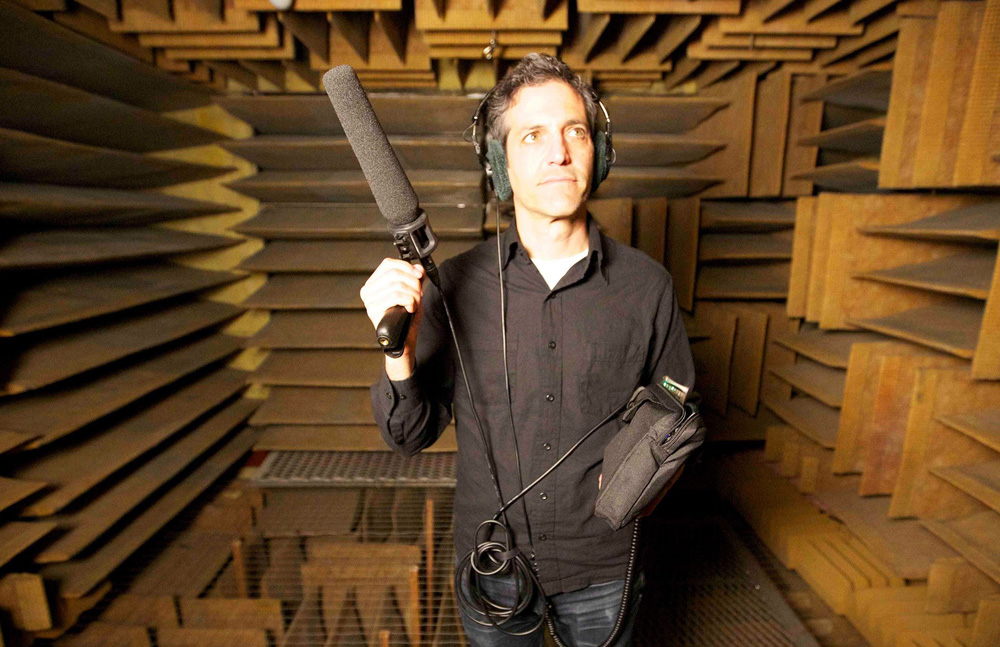At one point early in “32 Sounds,” Sam Green pays a visit to Annea Lockwood, an avant garde composer who now lives in upstate New York alongside the Hudson River. Green is handed headphones so he can hear what she has, the roiling, robust world just beneath the surface of the water — and the film, through the mad sorcery of Green and his sound designer Mark Mangini, is mixed so that one can experience the surprise he does of the sea coming alive inside his ears while still getting a sense of the relative calm he’s surrounded by above ground as the gentle breeze and the reeds that surround the lake make their presence known ever so slightly, arousing all the senses and making one conscious of the variety of sonic landscapes all around us.
Headphones are optional for watching “32 Sounds,” though Green and the film’s composer JD Samson kindly implore one to put them on at the start of the project that was intended to be presented as both a film and a live experience much like the director’s previous work “A Thousand Thoughts,” where it was accompanied on tour by the Kronos Quartet. In these COVID times, the latter may have to wait – plans to premiere at Sundance where audiences would’ve had headsets with a specific binaural experience were shuffled into the virtual realm, but “32 Sounds” is inherently intimate, no matter how it’s received as an education of how sound works becomes a moving consideration of what it can become as memory and add to instinct.
As Green charts the potential of capturing sound from the time Thomas Edison invented the phonograph had profound implications beyond its practical purpose, with pundits immediately realizing that voices could carry beyond the grave. The modern-day tendency of some to keep voicemails on their phone of dearly departed loved ones has bore this out, but Green delves quite a bit deeper into the neurological reasons for why this is beyond the obvious nostalgic value, employing savvy sound design to demonstrate how what we hear can touch a nerve. Surely knowing how intimidating the science could be for a novice, Green sets the convivial tone early, not only with the fun invitation he includes with Samson to put on headphones, but the title card accompanying the silent fall of a tree in the forest, cheekily making the audience complicit when if it doesn’t involve them, it won’t work at all.
It does, and then some because although “32 Sounds” is not explicitly biographical, Green shows how personal all these sounds are to him, occasionally folding in footage from previous shoots that may ostensibly be about the matter at hand, whether it’s sitting with San Francisco author Harold Gilliam relating the sound of fog horns or in one of the film’s more heartrending passages, the Black revolutionary activist Nehanda Abiodun, who is taken back to her days in New York City through listening to songs of the ‘70s while living in exile in Cuba, but clearly has meaning for him well beyond that. It isn’t surprising that the film shares an editor — the great Nels Bangerter — with Kristen Johnson’s “Cameraperson,” which similarly let the craft of the filmmaker in small, impressionistic moments express the feeling of being there and often how deeply imprinted it is on their psyche, and Green seeks that out as well in the experts he talks to, often moving past what they know professionally to discuss what they can’t exactly put into words when it comes from their lived experience.
“32 Sounds” is well-balanced, both in terms of sound and pacing to allow all of this to settle in so one can be thoughtful about what they’re watching, and that’s necessary when Green playfully teases at times with aural experiments that gauge how perspective can change based on sound alone. Still, the film moves steadily between the head and the heart, illustrating the associations that are made through certain sounds and the inflections that emerge from our subconscious and putting the intangible within reach as sound waves come to invoke waves of emotion.
“32 Sounds” does not yet have U.S. distribution.




